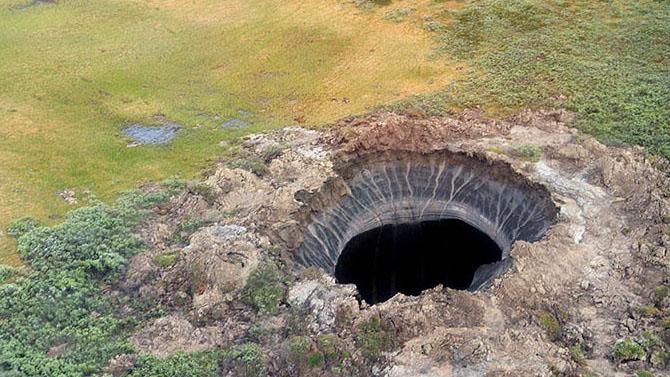Scientists are trying to get to the bottom of those mysterious new holes in Siberia
This gaping hole in the Siberian tundra was the first of two recently discovered on Russia’s far northern Yamal Peninsula. Scientists say the craters almost certainly appeared on the landscape only recently, and may be a result of a buildup of gas underground, linked to a warming climate.
If you've seen the pictures online like the one above, you’re probably among the millions wondering: What in the world are those huge new holes in Siberia?
The discovery of two bizarre craters in the permafrost tundra of far-northern Russia has kicked off a whirl of "X-Files"-like speculation about possible extraterrestrial origins. The real story is almost certainly more Earthly, but few scientists have actually been able to visit the sites on Russia’s Yamal Peninsula to gather data.
Geologist Vladimir Romanovsky, head of the Permafrost Laboratory at the University of Alaska Fairbanks hasn't seen the holes firsthand, but he's been in touch with Russian colleagues who have.
The ghostly images they've brought back show holes about 20-30 meters across and perhaps 10 meters deep. They have smooth, icy walls and pools of grey water on the bottom. But Romanovsky says the most interesting part is the material surrounding the huge holes.
“It looks like (it) was ejected from the hole,” he says, describing the one hole most closely studied so far. “That really makes this kind of feature a mystery.”
In many ways, Romanovsky says, it looks like one of the big sinkholes that are increasingly common in the Arctic. “But sinkholes actually collapse inside," he explains. "This one, it seems like it's erupted.”
The relatively fresh dirt surrounding the holes and the small amount of liquid water on the bottom makes him pretty sure they formed fairly recently, probably within the last year or so. So how in the world could that have happened?
We won’t know for sure until data collected by Russian scientists is analyzed, Romanovsky says. But from talking with his Russian colleagues, and from his own work studying permafrost and tundra in Alaska, his best guess is that it’s related to the “very significant” effects of the warming climate in the Arctic.
He speculates that warming air temperatures caused a patch of permafrost to thaw, which in turn caused some buried ice to melt and form a big underground cavity. But unlike sinkholes, the ground above didn’t collapse. Instead, Romanov says, it seems that in this cavity, “for some reason, pressure increased dramatically, and eventually the pressure was more than the ground above can hold — and that was exploded, erupted.”
And what would have caused the pressure increase? Perhaps natural gas from underground formations, Romanovsky guesses, or methane from thawing permafrost. Or it may have been something else having to do with the specific geology of the area, which was once part of the sea floor.
Either way, he expects the phenomenon will not prove unique. Having discovered these two new giant holes, Romanovsky thinks people will quickly start finding more across the Arctic — and that others will continue to form.
In fact, he wonders if he spotted one just last week in western Alaska: “I was in [the] Seward Peninsula area, and I saw a very, very similar round lake. It's already vegetated a little bit so it's definitely old, but … you can imagine, instead of this round lake, this hole there.”
Romanov even wonders if the sudden appearance of these “new” holes could help solve the mystery of the formation of countless other nearly round lakes in the Arctic that formed thousands of years ago, as the last ice age was ending.
From a scientific perspective, he says, the phenomenon is exciting, giving scientists a lot to chew on. But he says it may well create real concerns for others. What would happen if one of these holes erupted under a settlement, or an oil or gas operation?
“Remember, this is happening in the Yamal Peninsula, which right now is a very rapidly developing region in terms of gas and possibly oil extraction," Romanov says. “So that's very important to keep in mind, and now people should pay attention to this kind of phenomena.”
Our coverage reaches millions each week, but only a small fraction of listeners contribute to sustain our program. We still need 224 more people to donate $100 or $10/monthly to unlock our $67,000 match. Will you help us get there today?
